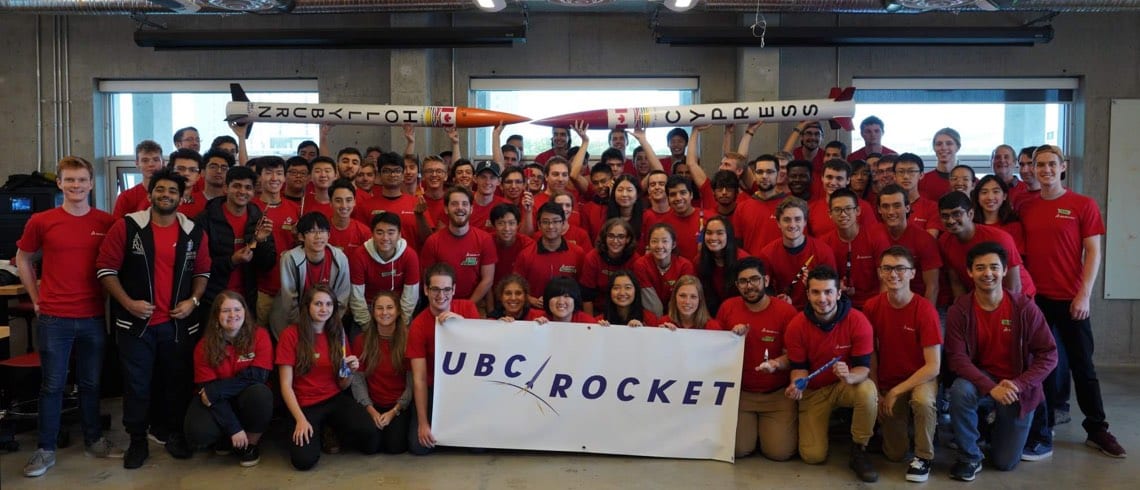A group of engineering students at the University of British Columbia, Canada, called UBC Rocket, continues to make the news with impressive rocket designs, and we are glad to offer them microcontrollers and development boards to push their models further. In our ongoing series delving into ST Technologies in Universities, we wanted to look at how UBC Rocket uses our technologies in their various designs as they prepare for the Spaceport America Cup 2019 where they will be attempting to launch a rocket at 30,000 feet (9,000 meters). The team also held an open house last April to make rocketry more accessible to their community while also recruiting new members.
Avionics is a complex subject. Every gram counts and even if the PCB is in the chassis, it can potentially hamper the overall aerodynamic performances. Teams must thus place antennas and sensors at strategic locations to get an accurate reading without any impact on the aircraft’s flight, while engineers must also work to use as few wires and batteries as possible to avoid weighing the whole system down. To make their lives easier, the team uses a similar PCB across their various vehicles, which enables them to reuse components and code. For instance, the avionics for their 10,000 feet and 30,000 feet rockets uses an analogous apogee detection system to recognize if the aircraft reached its highest altitude and must, therefore, release its parachute. It is thus an honor to have our component at the core of this platform.
Choosing an STM32F4 for Its CAN Interfaces

Even if there are some differences between each rocket, the engineering students use an STM32F4 microcontroller (MCU) across all their designs. One feature that mainly drew UBC Rocket toward our platform was that we offer multiple CAN (Controller Area Network) interfaces, which is a standard in aerospace applications because of its reliability. Using a CAN bus enables the microcontroller to communicate directly with other devices without needing to go through a central host. Since the students use multiple PCBs within the chassis, they installed a CAN transceiver on all of them to optimize the robustness of the data exchanges between each of these elements. The protocol also includes four error detection mechanisms to guarantee the integrity of the messages, which is crucial in such an application because even the slightest error could have dire consequences.
A CAN bus will also simplify their design. Historically, the engineers that started working on this protocol in the early 80s were trying to reduce the amount of electrical wiring necessary in vehicles because they wanted to use less copper, which was particularly expensive at the time. Today, this technology is a perfect fit for a rocket that must weigh as little as possible while also undergoing a tremendous amount of stress during takeoff. In fact, even the European Space Agency issued a document recommending that all on-board communication and control systems aboard spacecraft use the CAN protocol, which makes the aircraft from UBC Rocket a model of engineering while placing our components at the center of these innovations.
Choosing ST For Its Datasheet, Schematics, and BOM

Rocket design is not only complex but very sensitive, because the most minute of errors can cause the whole craft to fail. Component selection is thus a comprehensive process, which also explains why UBC Rocket likes to reuse parts they trust. As the team explained:
“We came across the STM32F4 and did the research ourselves. Looking at its specifications, tolerances, and features, we concluded that it was the best microcontroller for our application. As a result, we reached out to ST and are really excited that we got them to sponsor our project.”The team’s decision also came after they looked at our copious documentation on the st.com website, such as our datasheets, but also the schematics and bill of materials of our Nucleo boards, which helped them design their custom PCB. Offering such an outline ensured that the team didn’t miss a capacitor or resistor when they developed the IC for the microcontroller, and could, therefore, move past the prototyping phase faster. UBC Rocket also used our Nucleo development boards to facilitate their software debugging operations and to prepare their teams for the final PCB.
Moreover, the students explained that they use the ST Nucleo boards to develop their telemetry system. As the team highlighted:
“We relied on the Nucleo development boards because we are still learning embedded systems. It was thus important for us to have something that was robust and reliable to ensure that we could run our projects with more confidence, focusing on perfecting our code rather than troubleshooting our foundation.”
Looking Beyond the Sky
The next step for UBC Rocket is to continue to optimize their system by reducing the overall power consumption, without sacrificing critical features. The team also shared how this project is an essential stepping stone into the world of design processes and project management. What they learn will accompany them throughout their professional careers. Indeed, beyond the hardware and software, the students also had to deal with partners, budgets, public relations, and face many other challenges. They also have big plans and hope to be one day the first student team to launch a rocket into space, a truly ambitious goal that we are proud to support, and we can’t wait to see what they will launch next.
Check out ST Technologies in Universities:
- The STM32 Step-by-Step Guide Will Make an Expert ST Developer Out of You
- Automated Irrigation System, Smart Agriculture with Nucleo Boards and Sigfox
- SensorTile Capstone Projects Bring Basketball to Machine Learning
- Programming Your STM32 Embedded System in… Assembly?!
- Two Life Lessons from Learning Embedded Systems with SensorTile
